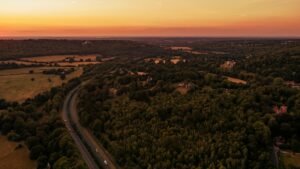Nestled in the Mule Mountains of Southern Arizona, Bisbee is more than just a historic mining town—it’s a goldmine of charm, creativity, and vintage flair. For travelers with an eye for character-filled adventures, this desert gem delivers in spades. From colorful alleyways to offbeat treasures, Antique Shops and Bodega Cafe in Bisbee AZ are at the heart of its unique appeal.
Whether you’re planning a road trip or searching for the best Bisbee AZ vintage shopping experiences, this town offers something truly special. In this guide, we’ll walk you through the must-visit spots, share local secrets, and help you uncover the most memorable things to do in Bisbee Arizona—especially if you’re building your own Bisbee antique store guide.
Table of Contents
Why Bisbee is an Antique Lover’s Paradise
Step into the world of Antique Shops and Bodega Cafe in Bisbee AZ, and you’ll feel like you’ve left the present behind. The winding alleys, colorful staircases, and historic facades of this quirky town create the perfect atmosphere for discovery. It’s no wonder Bisbee AZ vintage shopping has become a favorite pastime for both locals and visitors.
Unlike big-city antique malls, Bisbee offers a more soulful experience. Here, each antique shop is a reflection of the owner’s personality—filled with unique finds, vintage oddities, and stories from decades past. These aren’t your typical, cookie-cutter retail spots. They’re Bisbee antique store guide gems, tucked into corners of the historic district, waiting to be uncovered.
If you’re compiling a list of things to do in Bisbee Arizona, exploring the antique scene is a must. You’ll not only find one-of-a-kind treasures, but you’ll also get a real sense of the town’s creative spirit and history. It’s the kind of place where every cracked leather suitcase, every faded postcard, and every retro lamp seems to whisper its own story.
So whether you’re a serious collector or just browsing for something nostalgic, Bisbee’s antique charm promises an experience that’s as memorable as the finds you take home.
Top Antique Shops in Bisbee AZ
If you’re planning a weekend escape or a spontaneous day trip, exploring the Antique Shops and Bodega Cafe in Bisbee AZ is one of the most rewarding things to do in Bisbee Arizona. This historic town’s vintage scene is both quirky and authentic—perfect for collectors, creatives, and casual browsers alike. Here are three standout spots that define Bisbee AZ vintage shopping:
1. Finders Keepers Antiques

Tucked along the colorful stretch of Main Street, Finders Keepers is a cornerstone of the Bisbee antique store guide. This welcoming shop features a curated selection of mid-century furniture, retro vinyl records, Depression-era glassware, and even rare mining artifacts that whisper tales from Arizona’s copper-boom past.
Locals rave about the warm hospitality—don’t be surprised if the owner shares insider stories about the building’s own history or recommends other hidden gems nearby.
2. Belleza Fine Art Gallery & Antiques

Combining creativity and curation, Belleza is more than just an antique shop—it’s a gallery that celebrates Bisbee’s artistic roots. Here, vintage finds sit beside original artwork, handcrafted Native jewelry, and rustic Southwestern décor.
It’s the kind of place where you can stumble across a rare 19th-century painting and a hand-thrown pottery vase all in the same room. Belleza is a must-see stop for those who appreciate both artistic craftsmanship and historical depth.
3. Acacia Antiques

Acacia Antiques is a hidden gem nestled in a cozy downtown nook. With a whimsical blend of Americana, upcycled vintage goods, old postcards, and travel trunks straight out of a 1930s road trip, this shop feels like a time capsule curated with love.
It’s the kind of place where every corner reveals a surprise—from retro toys and rusty signs to delicate lace from another era. It’s perfect for photographers, decorators, and nostalgic hearts.
Antique Shops and Bodega Cafe in Bisbee AZ create an unforgettable loop of exploration. As you shop these storied spaces, you’ll be drawn into the unique culture that defines this offbeat Arizona town. Whether you’re a collector, artist, or weekend wanderer, these vintage stops offer a slice of the past you’ll want to take home.
The Cozy Soul of the Town: Bodega Cafe in Bisbee AZ
You can’t fully enjoy the charm of Antique Shops and Bodega Cafe in Bisbee AZ without spending time at the local cafés that give this artsy town its soul. And leading the pack is the cozy, quietly iconic Bodega Cafe in Bisbee AZ. Whether you’re just starting your morning or taking a mid-day break from Bisbee AZ vintage shopping, this place feels like home.
What to Expect at Bodega Cafe
Bodega Cafe isn’t flashy—but that’s its magic. It’s a gathering space for locals, day-trippers, and antique treasure hunters alike. Here’s why it deserves a stop on your vintage-inspired itinerary:
- Locally-roasted coffee with subtle chocolate and spice notes that fuel your stroll through antique-lined streets
- House-made pastries like lavender scones and prickly pear muffins—flavors as unique as the town itself
- Brunch specials on weekends that locals swear by (don’t miss the green chile quiche)
- A breezy outdoor patio—perfect for people-watching, journal writing, or planning your next stop on the Bisbee antique store guide
At any given time, you’ll find a mix of sketching artists, hikers fresh off the trail, and vintage enthusiasts swapping stories over iced oat lattes. It’s not just a café—it’s a rhythm in the town’s heartbeat.
How to Spend a Perfect Day Exploring Antique Shops and Bodega Cafe in Bisbee AZ
Looking for fun and fulfilling things to do in Bisbee Arizona? Here’s a relaxed yet enriching itinerary centered around Bisbee’s antique scene and the beloved Bodega Cafe:
Morning
- Start your day with a smooth pour-over and scone at Bodega Cafe in Bisbee AZ
- Stroll through the historic district and admire the architecture—don’t forget your camera!
Midday
- Dive into Bisbee AZ vintage shopping with visits to Finders Keepers, Acacia Antiques, and other hidden spots
- Grab a handcrafted sandwich or seasonal salad at Bisbee Coffee Company, or circle back to Bodega for a second round of caffeine and conversation
Afternoon
- Continue your antique hunt or pop into one of the local art studios
- Enjoy street musicians, small pop-up exhibits, or check out the Bisbee Mining & Historical Museum for context on the treasures you’ve been browsing
Evening
- Have dinner at a cozy local bistro—like Cafe Roka or Thuy’s Noodle Shop
- Stay overnight in the historic Copper Queen Hotel (rumored to be haunted—just enough to keep things exciting!)
Getting There and Parking Tips
- Bisbee is about 90 minutes southeast of Tucson, Arizona via scenic Highway 80
- Street parking is available in downtown, but weekends fill up quickly—arrive early for a stress-free start
- Wear comfortable shoes. Bisbee’s beauty lies in its hillside layout, colorful staircases, and sloped roads that are best explored on foot
What are the best antique shops to visit in Bisbee, AZ?
Some of the most popular antique shops in Bisbee include Finders Keepers Antiques, Acacia Antiques, and Belleza Fine Art Gallery & Antiques. Each offers a unique collection of vintage items, collectibles, and local history pieces.
Is Bodega Cafe in Bisbee AZ worth visiting?
Absolutely! Bodega Cafe in Bisbee AZ is a local favorite, known for its artisanal coffee, homemade pastries, and relaxed patio atmosphere. It’s a must-stop for visitors exploring the downtown antique district.
What are some fun things to do in Bisbee, Arizona besides shopping?
In addition to Bisbee AZ vintage shopping, visitors can explore the Queen Mine Tour, wander historic staircases and murals, visit the Bisbee Mining & Historical Museum, and enjoy scenic hikes around the mountains.
When is the best time to visit Bisbee for antique shopping?
Spring and fall are the best seasons for comfortable weather and open shop hours. Weekends are livelier, with most antique stores and cafes in full swing.
Is Bisbee AZ walkable for exploring antique shops and cafes?
Yes! Downtown Bisbee is very walkable. Most antique shops and Bodega Cafe are within walking distance of each other, though comfortable shoes are recommended due to the town’s hills and staircases.
Final Thoughts: Antique Shops and Bodega Cafe in Bisbee AZ
If you’re planning a Southwest getaway that blends history, charm, and a touch of the unexpected, exploring the Antique Shops and Bodega Cafe in Bisbee AZ should be at the top of your list. From browsing rare collectibles to sipping artisan coffee with mountain views, this hidden Arizona gem delivers an experience that’s equal parts soulful and nostalgic.
Whether you’re deep into Bisbee AZ vintage shopping or just browsing for fun, the town invites you to slow down and enjoy life’s finer, simpler moments. Take in the copper-era architecture, chat with shop owners, and don’t forget to grab something sweet from the Bodega before heading home.
If you’re building your own Bisbee antique store guide or mapping out unique things to do in Bisbee Arizona, this town will surprise you in the best ways.
So pack light—except for that extra tote bag you’ll need for your vintage finds—and let Bisbee’s magic unfold one storefront at a time.




